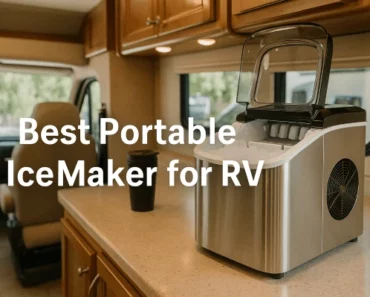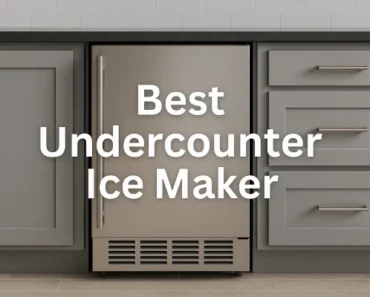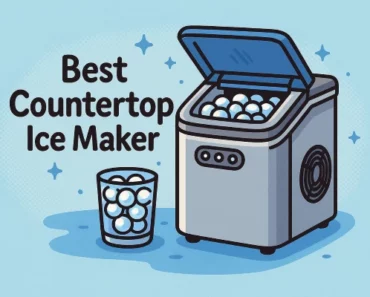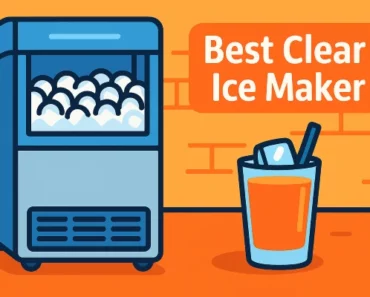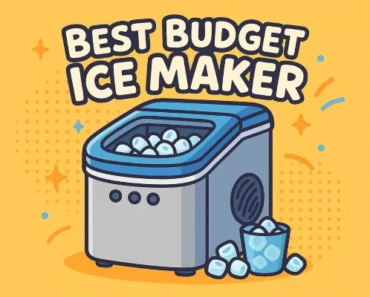Buying the best commercial ice maker is crucial for any successful food and beverage business, as these behind-the-scenes ice makers completely impact the guest satisfaction. For restaurants, bars, hotels, cafes, and even offices, commercial ice makers aren’t just conveniences—they’re essential appliance built for volume, consistency, and durability.
Unlike residential models that produce a small quantity of ice each day, commercial ice makers deliver reliable performance even in the most intense service periods. Commercial ice maker’s robust design ensures longevity under pressure, resulting in fewer maintenance issues, consistent ice quality, and finally, happier customers.
No need to waste time browsing other sites for the perfect ice maker to suit your needs. Here at Ice Artisan:
- I continually update my list of top ice makers to ensure you always get the latest, best ice maker.
- I deliver honest reviews—as a full-time ice maker technician—so you can make the best choice.
- I never hype a product just to earn a click or a sale.
Related posts:
Best commercial ice maker comparison table: My top picks
Short on time? I’ve used AI to put together this comparison table of my best commercial ice maker recommendations. You’ll find prices, features, and specs at a glance, making it easy to spot which model works best for your bar. See something you like? Just click “Read more” for my detailed hands-on review.
| Model | Price | Daily Production | Ice Type | ||
|---|---|---|---|---|---|
![Best commercial ice maker: Heavy-duty ice machines in [year] 1 Hoshizaki AM-50BAJ](https://iceartisan.com/wp-content/uploads/2025/04/Hoshizaki-C-80BAJ.webp) |
Hoshizaki AM-50BAJ | $3,000 | 51-55 lbs/day | Crescent Gourmet Ice | Read more |
![Best commercial ice maker: Heavy-duty ice machines in [year] 2 NewAir NCI080SS00](https://iceartisan.com/wp-content/uploads/2025/05/NewAir-NCI080SS00.webp) |
NewAir NCI080SS00 | $899 | 80 lbs/day | Clear Cube Ice | Read more |
![Best commercial ice maker: Heavy-duty ice machines in [year] 3 Euhomy Commercial](https://iceartisan.com/wp-content/uploads/2025/04/Euhomy-Commercial.webp) |
Euhomy Commercial | $1,200 | 80-95 lbs/day | Clear Cube Ice | Read more |
![Best commercial ice maker: Heavy-duty ice machines in [year] 4 Summit Appliance BIM44GADA](https://iceartisan.com/wp-content/uploads/2025/04/Summit-BIM44GADA.webp) |
Summit Appliance BIM44GADA | $1,950 | 50 lbs/day | Crescent Ice | Read more |
![Best commercial ice maker: Heavy-duty ice machines in [year] 5 KoolMore KM-BIM66-NSS](https://iceartisan.com/wp-content/uploads/2025/05/KoolMore-KM-BIM66-NSS.webp) |
KoolMore KM-BIM66-NSS | $1,500 | 66 lbs/day | Nugget Ice | Read more |
![Best commercial ice maker: Heavy-duty ice machines in [year] 6 Ice-O-Matic ICEU220FA](https://iceartisan.com/wp-content/uploads/2025/05/Ice-O-Matic-ICEU220FA.webp) |
Ice-O-Matic ICEU220FA | $3,000 | 238 lbs/day | Full Cube Ice | Read more |
![Best commercial ice maker: Heavy-duty ice machines in [year] 7 Scotsman CU0515GA-1](https://iceartisan.com/wp-content/uploads/2025/04/Scotsman-CU0515GA-1.webp) |
Scotsman CU0515GA-1 | $3,200 | 84 lbs/day | Gourmet Clear Ice | Read more |
![Best commercial ice maker: Heavy-duty ice machines in [year] 8 Ice-O-Matic UCG130A](https://iceartisan.com/wp-content/uploads/2025/05/Ice-O-Matic-UCG130A.webp) |
Ice-O-Matic UCG130A | $2,900 | 121-126 lbs/day | Gourmet Ice | Read more |
![Best commercial ice maker: Heavy-duty ice machines in [year] 9 Manitowoc CNF0201A](https://iceartisan.com/wp-content/uploads/2025/05/Manitowoc-CNF0201A.webp) |
Manitowoc CNF0201A | $5,500 | 315 lbs/day | Nugget Ice | Read more |
![Best commercial ice maker: Heavy-duty ice machines in [year] 10 Scotsman UN1520A-1](https://iceartisan.com/wp-content/uploads/2025/05/Scotsman-UN1520A-1.webp) |
Scotsman UN1520A-1 | $4,100 | 167 lbs/day | Nugget Ice | Read more |
Best commercial ice maker in 2025
My Pick
In the competitive hospitality industry, ice quality can significantly elevate the drinking experience your bars or restaurants offers. After testing dozens of commercial ice makers throughout my career as a professional ice maker technician, the Hoshizaki AM-50BAJ stands out as the best commercial ice maker, without destroying your balance.
We all love the extraordinary Japanese engineering heritage backed by American manufacturing excellence, and Hoshizaki is your “Made in Japan” commercial ice maker. Founded in Japan in 1981, Hoshizaki brings half century of precision craftsmanship to every ice maker they build. The Hoshizaki AM-50BAJ’s stainless steel construction isn’t just about looks – it’s built with the same painstaking attention to detail that made Japanese products top-notch worldwide. Even during your bar’s busiest hours, this workhorse keeps producing perfect ice without mistake. I found these units performing flawlessly after a decade of nonstop service – a symbol of legendary durability thanks to Hoshizaki’s rigorous quality control.
![Best commercial ice maker: Heavy-duty ice machines in [year] 11 best commercial ice maker](https://iceartisan.com/wp-content/uploads/2025/05/Hoshizaki-C-80BAJ_1.webp)
The crown jewel of this machine, however, is its gourmet ice production. If you’ve been in the business long enough, you know that not all ice is created equal. The crystal-clear, perfectly formed “top hat” cubes this machine produces have transformed cocktail programs across the industry. These signature gourmet cubes melt significantly slower than standard ice, preserving drink integrity without affecting flavor—something your customers will love.
When serving premium spirits, the visual appeal of the ice matters as much as the cocktail’s taste. The Hoshizaki creates distinctive “Top Hat” style ice – perfectly cylindrical cubes with smooth, rounded edges that stand about 1-inch tall. The high-end drinks can make customers reach their phones to share your stories immediately after.
Gourmet ice has become increasingly popular for bars, lounges, restaurants, and hotels looking to enhance their drink presentations, especially when craft cocktails are on the menu. Your customers can easily notice why their Old Fashioned tastes better at your place, and that’s a secret you should keep.
This commercial ice maker might cost upfront, but it pays off quickly. Bar owners report saving money through less ice waste and fewer repairs. Plus, customers notice the difference in their drinks—and that premium experience keeps them coming back. The better ice quality alone justifies the price tag for most businesses in the beverage industry.
Related post: Best ice maker 2025.
Under $2000
Best budget commercial ice maker
The NewAir NCI080SS00 stands out as the budget-friendly champion for deliver crystal-clear ice service without excessive investment as top names like Scotsman, Hoshizaki or Manitowoc.
![Best commercial ice maker: Heavy-duty ice machines in [year] 12 best commercial ice maker](https://iceartisan.com/wp-content/uploads/2025/05/NewAir-NCI080SS00_1.webp)
Priced at around $800, this commercial ice maker delivers professional-grade results at a fraction of what traditional commercial ice machine names cost. While it can’t match the decade-plus longevity of premium $2,000+ machines, the build quality remains impressive for its price point. NewAir seems to be a Chinese brand under the vague American hood, still the NewAir NCI080SS00 truly shines is ice quality. The crystal-clear cubes it makes can rival even an Ice-O-Matic, with high clarity and the slow melt rate essential for preserving flavor profiles in premium cocktails.
Medium-size clear ice cubes are perfect for cafe owners who need quality and smaller upfront cost. These medium cubes are perfect for a strong iced Arabica coffee, with no spoonful – without the cost of machines that make large cubes primarily targeted in high-end pubs. The crystal-clear ice substantially outperforms standard cloudy ice, justifying a bit more menu price increases with minimal investment. However, if you’re looking for large cube ice makers, continue to my next recommendation.
Related post: Best clear ice maker.
Best budget commercial ice maker for large cubes
For bar and restaurant owners who found the medium-sized cubes from the NewAir NCI080SS00 not appealing for premium service, the Euhomy Commercial Ice Maker ups the larger ice size. This model brings substantially larger ice cubes that have become the standard in bars serving premium spirits and craft cocktails, where presentation significantly influences value.
![Best commercial ice maker: Heavy-duty ice machines in [year] 13 best commercial ice maker](https://iceartisan.com/wp-content/uploads/2025/05/Euhomy-Commercial_1.webp)
At a more affordable price, this commercial Euhomy ice maker does a good job in long-term durability and compressor longevity. While you shouldn’t expect the decade-plus lifespan of high-end machines, its commercial-grade stainless steel construction and ETL certification provide surprising resilience for the price point. It’s also the classic budget decision: accept potential replacement in 2-3 years or paying thousands upfront.
Large ice cubes have become essential for craft cocktail service, where proper dilution control directly impacts drink quality. These substantial clear cubes melt significantly slower than standard ice, preserving flavor profiles in premium spirits and high-margin cocktails without excessive watering down. This size difference can create a visual upgrade for your customers.
The Euhomy ice maker has storage capacity and daily production even better than the Hoshizaki AM-50BAJ, so it can handle high-volume service demands without running short. This makes it particularly valuable for larger restaurants and busy bars where keeping pace with demand takes priority over achieving absolute premium quality. The substantial capacity means no shortage that disrupt operations during peak hours, which is vital for many restaurant owners.
Best mid-range commercial ice maker
When reliability matters as much as ice quality, the Summit Appliance BIM44GADA bridges the gap between the budget-friendly Euhomy and premium-priced alternatives. Backed by an American manufacturing legacy dating to 1969, Summit brings established engineering standards that justify the price increase over economy models. While costing more than the Euhomy, it still represents significant savings compared to high-end Scotsman or Hoshizaki units that can command $3,000-4,000 for similar output capacity.
![Best commercial ice maker: Heavy-duty ice machines in [year] 14 best commercial ice maker](https://iceartisan.com/wp-content/uploads/2025/05/Summit-BIM44GADA_1.webp)
The Summit BIM44GADA produces the standard large clear ice cubes, which is the most popular ice type when businesses look for a commercial ice maker. These large cubes deliver the premium presentation and slow melt rate essential for craft cocktails and premium spirits. We also have the high clarity in the Summit ice quality, as much as other bigger names in ice maker manufacturing.
What truly distinguishes the Summit from budget alternatives is its commercial-grade construction and NSF certification – crucial validation for businesses where reliability impacts revenue. While having a higher price than the Euhomy, the Summit’s insulated storage bin better maintains ice quality during busy service periods. Still, it’s a sacrifice for not choosing more expensive commercial ice makers, the Summit BIM44GADA’s ice quality can’t last as long as the Hoshizaki AM-50BAJ.
Related post: Best ice maker for RV.
Best budget commercial ice maker for pearl ice
The KoolMore KM-BIM66-NSS offers an affordable entry point into the great world of pearl ice without the premium price of top-end machines like the Ice-O-Matic GEMU090. KoolMore brings commercial-grade equipment to the market at accessible price points, positioning their products as quality alternatives to higher-priced competitors.
![Best commercial ice maker: Heavy-duty ice machines in [year] 15 best commercial ice maker](https://iceartisan.com/wp-content/uploads/2025/05/KoolMore-KM-BIM66-NSS_1.webp)
What distinguishes this model is its production of pearl-style nugget ice – that soft, chewable ice with a devoted following in bars and restaurants. Though slightly firmer than genuine nugget ice, it still delivers the essential characteristics that make this ice type popular: better flavor absorption, ideal texture for blended drinks, and enhanced presentation in specialty cocktails.
Despite being categorized as “nugget” ice, the KoolMore’s output maintains a higher density than standard nugget ice, resulting in a surprisingly slower melt rate – crucial for maintaining flavor profiles without excessive dilution. This makes it particularly valuable for establishments serving signature cocktails where preserving taste complexity matters.
Where the KoolMore truly excels is bridging the quality/price gap – delivering approximately 80% of the premier Ice-O-Matic’s performance at roughly half the cost. For bars and restaurants building their craft beverage program on a budget, this represents the most accessible commercial ice maker of pearl ice without deeper pocket.
Related post: Best nugget ice maker.
Under $4000
Best commercial ice maker for large ice cubes
The Ice-O-Matic ICEU220FA stands as the gold standard for serious bars and restaurants who refuse to compromise on ice quality. With their singular focus on ice technology, Ice-O-Matic has earned global recognition for producing commercial machines that are “simple, reliable and easy-to-use” without compromising performance.
![Best commercial ice maker: Heavy-duty ice machines in [year] 16 best commercial ice maker](https://iceartisan.com/wp-content/uploads/2025/05/Ice-O-Matic-ICEU220FA_1.webp)
True engineering philosophy, not merely build quality, distinguishes this model from everything in the budget category. The full-cube ice produced by this machine is specifically designed for slow melting in upscale cocktails, ensuring drinks maintain their flavor integrity without premature dilution. These large cubes have become the industry standard in craft cocktail bars where presentation and preservation of flavor profiles are must-have.
Professional users consistently report the Ice-O-Matic’s superior durability under pressure, particularly crucial during peak service hours when lesser machines begin to struggle. The electroless nickel plating on critical components transforms this from just another appliance into a long-term business investment with demonstrably lower lifetime costs.
If you prefer large cube ices than gourmet ices, the Ice-O-Matic ICEU220FA should be a great alternative to the Hoshizaki AM-50BAJ. For businesses where ice isn’t just cooling but part of the craft beverage experience, the Ice-O-Matic ICEU220FA delivers what cheaper alternatives can’t promise.
Related post: Best undercounter ice maker.
Challenger of the best commercial ice maker for gourmet ice
The Scotsman CU0515GA-1 represents American ice-making tradition at a slightly more accessible price point than the elite Hoshizaki AM-50BAJ. With a manufacturing legacy dating back to 1950 when they introduced their first crystal-clear ice cube, Scotsman has grown to become “the world’s leading manufacturer of ice machines” with production proudly centered in their award-winning South Carolina facility.
![Best commercial ice maker: Heavy-duty ice machines in [year] 17 best commercial ice maker](https://iceartisan.com/wp-content/uploads/2025/05/Scotsman-CU0515GA-1_1.webp)
This model produces the coveted top-hat gourmet ice prized in upscale cocktail programs, though with slightly less clarity and marginally faster melt rates compared to the Hoshizaki. Its gourmet ice is “uniquely shaped, crystal clear, slow melting and odorless,” ensuring minimal flavor dilution – crucial for premium spirits and craft cocktails where preserving complex flavor profiles is essential. The distinctive shape prevents clumping while maintaining the professional presentation customers associate with high-end establishments.
Scotsman stands behind their products with substantial warranty protection: 3 years parts and labor plus 5 years on the compressor and condenser components – reflecting the company’s confidence in their engineering and American manufacturing standards. This comprehensive coverage provides significant peace of mind for businesses where ice production directly impacts revenue and customer satisfaction.
For bar and restaurant owners seeking the prestige of gourmet ice without stretching to Hoshizaki’s premium price point, the Scotsman offers a compelling middle ground. Businesses particularly appreciate that “100% of units make ice before leaving the plant,” demonstrating Scotsman’s commitment to quality control and performance verification – a manufacturing approach that consistently earns them recognition among the top manufacturers in the USA.
Best commercial ice maker for clear gourmet ice
While Hoshizaki AM-50BAJ remains my pick, the Colorado-based Ice-O-Matic UCG130A deserves serious consideration for the best bar owners. This American-engineered marvel has been designed and manufactured in Denver, Colorado since 1952, when founder Dave Smith established the company with a mission to offer the best ice machines in the business.
![Best commercial ice maker: Heavy-duty ice machines in [year] 18 best commercial ice maker](https://iceartisan.com/wp-content/uploads/2025/05/Ice-O-Matic-UCG130A_1.webp)
The Ice-O-Matic UCG130A produces gourmet cube-style ice with dimensions of approximately 1″ x 1¼” x 1¼”, generating up to 121 lbs of ice daily with a 48½ lb storage capacity. Bar professionals recognize that Ice-O-Matic’s exceptional transparency isn’t merely aesthetic – it’s functional brilliance. The high purity and clarity ensure the flavors of premium spirits are maintained, while the slow melt rate keeps drinks from getting watered down, preserving drink integrity without dilution.
The remarkable clarity results from the production process that creates denser ice with fewer air bubbles, which not only looks more appealing but scientifically slows the melting process. Clear ice has less surface area to encourage melting due to the absence of air pockets on the exterior, creating a smooth surface that melts slower than cloudy alternatives.
Bar owners who love the Ice-O-Matic will surely fall for this commercial ice maker. For most of you reading my article to find the best commercial ice maker, the Ice-O-Matic UCG130A is certainly one you can’t simply ignore. If you want sharp-edge gourmet ices, or if you can find my deal for the ice maker cheaper than the Hoshizaki or Scotsman, I urge you to jump the boat.
Best commercial countertop ice maker for nugget ice
The Manitowoc CNF0201A stands as the only countertop model in my best commercial ice maker lineup, excelling specifically in healthcare and rehabilitation environments. Hailing from Wisconsin, where the company was established in 1964, Manitowoc has built a sterling reputation for innovation and reliability in ice-making technology. Now part of Pentair following a 2022 acquisition, the brand maintains its commitment to engineering excellence.
![Best commercial ice maker: Heavy-duty ice machines in [year] 19 best commercial ice maker](https://iceartisan.com/wp-content/uploads/2025/05/Manitowoc-CNF0201A_1.webp)
The Manitowoc CNF0201A produces nugget ice – soft, chewable pellets prized in healthcare settings for their gentle texture. This specialized ice is ideal for patients with difficulty swallowing or dental sensitivity, simultaneously providing effective cooling for beverages and therapeutic treatments.
Unlike undercounter models typically found in bars, this countertop configuration is purpose-built for spaces where accessibility is limited – nursing stations, rehabilitation centers, and senior living facilities. Its compact footprint preserves valuable counter space yet maintains impressive production capacity.
Healthcare administrators appreciate that nugget ice minimizes choking hazards while maximizing patient comfort. The machine’s touchless dispensing promotes hygiene in settings where cross-contamination risks must be minimized.
Related post: Best countertop ice maker.
Best commercial ice maker for nugget ice
The hospitality world’s fascination with premium ice continues to evolve, with Scotsman UN1520A-1 is the best commercial ice maker for nugget ice. Pioneering commercial ice machines since the 1950s, this American manufacturer introduced “The Original Chewable Ice” in 1981, creating what would become an iconic offering in bars and restaurants nationwide.
![Best commercial ice maker: Heavy-duty ice machines in [year] 20 best commercial ice maker](https://iceartisan.com/wp-content/uploads/2025/05/Scotsman-UN1520A-1_1.webp)
The Scotsman UN1520A-1’s nugget ice delivers the perfect balance of texture and functionality, featuring superbly crunchy pellets that absorb beverage flavors while cooling drinks rapidly. This creates an elevated sensory experience that patrons actively seek out, particularly in establishments serving signature cocktails, premium spirits, and blended drinks.
Unlike standard cube ice, these compressed nuggets provide exceptional liquid displacement, making them ideal for establishments offering specialty drinks or bottomless refills. The faster melt rate – often viewed as a disadvantage – actually becomes an advantage in craft cocktail settings where controlled dilution enhances flavor development.
For businesses especially targeting nugget ice, Scotsman’s engineering excellence ensures that this small but significant detail consistently delights customers across every service. Honestly, when you’re looking for the best nugget ice, it’s Scotsman.
Related post: Best budget ice maker.
What to look for in the best commercial ice maker?
Ice production capacity (lbs per day)
In my years of working with commercial kitchen equipment, I’ve found that production capacity is the make-or-break metric that determines whether a commercial ice maker will be your kitchen’s hero or its headache. This measurement is calculated in pounds produced per 24-hour period under optimal conditions, shows the maximum output available to meet your service demands.
Getting the capacity right requires honest calculation of your daily requirements across all applications. Here’s what I typically advise based on real-world usage:
- Full-service restaurants: Plan for about 1.5 pounds per customer
- Craft cocktail businesses: You’ll need around 2.5 pounds per customer
- Quick-service operations with self-service beverage: Allow 3 pounds per customer
- Food display cases: About 30 pounds per case
- Healthcare facilities: About 10 pounds per bed
I always recommend sizing your production capacity at least 15-20% above your average requirements. This buffer is crucial for handling those inevitable rush periods without depleting your ice reserves. This becomes even more important if your business depends strongly on the produced ices.
Here’s something many manufacturers won’t tell you: their specs typically reflect perfect conditions (70°F air/50°F water). In the real world of hot kitchens, you’ll need to adjust expectations accordingly:
- 80°F ambient temperature typically causes an 8-12% capacity reduction
- 90°F ambient leads to a 15-20% capacity reduction
- In 100°F environments (not uncommon in busy kitchens), expect up to a 30% capacity drop
I’ve rescued countless operations that overlooked the relationship between production and storage. If your storage capacity is limited, you’ll need higher production rates to maintain availability during peak periods. I’ve seen too many businesses scramble during rush periods because they failed to compensate for limited storage with increased production capacity.
Ice storage bin size
Think of your ice storage bin as your buffer against demand spikes. The right storage capacity prevents service interruptions during peak times while avoiding wasted energy and unnecessary equipment cycling during normal operation.
From my experience installing systems across various operation types, optimal storage typically equals 50-80% of daily production capacity for well-balanced operations. This ensures sufficient reserve without excessive inventory aging or wasted capacity. However, this formula should be adjusted based on your demand patterns:
- Standard distribution (consistent usage throughout the day): 50% of daily production
- Moderate fluctuation (predictable peak periods): 65% of daily production
- Extreme fluctuation (event-driven demand spikes): 80%+ of daily production
The physical configuration of your storage bin directly impacts operational efficiency. I’ve found that top-opening designs maximize storage density but require staff to reach deeper for access, while front-opening configurations sacrifice some capacity for improved ergonomic access. For high-volume operations, elevated bins with gravity discharge dramatically improve distribution efficiency, while mobile configurations support flexible deployment across service areas.
One often-overlooked factor: insulation quality becomes critically important in warm environments. Premium bins with foamed-in-place polyurethane insulation significantly outperform those with mechanically inserted panels, which can develop thermal gaps over time. I’ve measured up to 40% less melt loss in well-insulated premium bins during summer months, a substantial operational saving that often justifies the higher initial investment.
Drain type: gravity vs pump
Your drainage system choice significantly impacts both installation flexibility and long-term operational reliability. The drainage mechanism has a critical job, evacuating both harvest water and incidental melt to prevent accumulation that could compromise production or create sanitation concerns.
Gravity drain
Gravity-based evacuation relies on natural forces to move water through drain lines positioned below the machine’s drainage point. After countless installations, I can attest to the advantages:
- No moving components means virtually no mechanical failure risk
- Zero energy consumption for drainage function
- Unlimited drainage volume capacity
- Minimal maintenance requirements and associated costs
The catch? Installation constraints can be significant:
- Requires drain access positioned below the machine
- Needs minimum 1/4″ per foot slope for proper flow
- Drain typically must be within 6 feet of installation
- Local plumbing codes often mandate specific air gap requirements
Pump-assisted drain
Pump systems use motorized impellers to move water through discharge plumbing regardless of gravitational relationship. This approach provides:
- Installation flexibility where gravity drainage isn’t practical
- Vertical lift capability (typically 8-10 feet elevation)
- Extended horizontal run capacity (up to 20+ feet in some configurations)
- Independence from drain proximity requirements
The tradeoffs? In my repair experience, these include:
- Additional mechanical components that introduce potential failure points
- Supplementary energy consumption during drainage cycles
- Limited volume capacity (typically 1-3 gallons per minute)
- Periodic pump maintenance requirements
My golden rule after years in the field: Always prioritize gravity systems wherever installation parameters permit, reserving pump systems only for circumstances where physical constraints make gravity drainage impossible.
Cooling method: air-cooled vs water-cooled
The condensing system fundamentally influences both operational efficiency and installation requirements. Having installed both types in countless environments, I can share the real-world implications of each approach.
Air-cooled system
These systems dissipate heat by forcing ambient air across condenser coils using motorized fans. The advantages include:
- Simplified installation requiring only standard plumbing connections
- Reduced water consumption limited to ice production only
- Lower operational costs in regions with high water expenses
- Reduced scale accumulation due to minimized water circulation
The limitations I’ve observed include:
- Decreased efficiency in elevated ambient temperatures (typically above 80°F)
- Clearance requirements for adequate airflow (typically 6-12 inches on compressor sides)
- Increased ambient heat contribution in enclosed spaces
- Higher operational noise levels from cooling fans
Water-cooled system
These systems circulate water across condenser coils to absorb and evacuate heat. The benefits include:
- Consistent production capacity regardless of ambient temperature conditions
- Quiet operation due to the absence of cooling fans
- Minimal side clearance for installation flexibility
- Significantly less ambient heat contribution to surrounding spaces
The considerations that often surprise new owners include:
- Substantially increased water consumption (typically 100-200 gallons per 100 pounds of ice)
- Higher installation complexity requiring dedicated water supply and drain lines
- Increased scale accumulation potential within the condensing system
- Higher long-term operational costs in regions with expensive water
After installing hundreds of systems in diverse environments, my recommendation is clear: prioritize air-cooled systems unless specific challenges like elevated ambient temperatures, noise concerns, or installation constraints make water-cooled configuration necessary.
Build quality and ease of service
I’ve spent thousands of hours repairing ice machines, and I can tell you firsthand that construction quality directly impacts both initial reliability and long-term viability. Premium materials and thoughtful design dramatically reduce maintenance headaches while extending productive lifespan.
Essential construction elements I look for include:
- Stainless steel exterior surfaces that resist corrosion and provide superior sanitation
- Well-insulated storage compartments with thermal barriers exceeding industry standards
- Corrosion-resistant evaporator plates (preferably nickel-plated or stainless steel)
- Self-cleaning capabilities that minimize manual intervention requirements
- Accessibility features facilitating routine maintenance procedures
Serviceability is the most overlooked aspect of commercial ice equipment selection. Systems designed with maintenance in mind deliver significantly reduced downtime and lower service expenses throughout their operational life. Critical serviceability features include:
- Front-accessible components eliminating extraction requirements for routine maintenance
- Diagnostic capabilities providing operational status information and fault identification
- Field-replaceable major components enabling on-site repair rather than full replacement
- QR-code access to digital maintenance resources and instructional materials
- Simplified water filtration systems with easily replaced cartridges
For operations with limited technical resources, I strongly recommend prioritizing systems with comprehensive manufacturer support networks. This includes readily available replacement components, responsive technical assistance, and extensive service documentation. I’ve seen too many businesses struggle with extended downtime simply because they chose equipment without considering parts availability or technical support.
Energy efficiency and certifications
Operational efficiency significantly impacts both environmental sustainability and your bottom line. High-efficiency systems minimize utility expenses while reducing environmental impact – considerations increasingly important for both corporate sustainability initiatives and regulatory compliance.
Essential efficiency features I recommend include:
- Energy Star certification validating performance exceeding current federal standards
- Advanced compressor technology with variable speed capabilities matching production to demand
- Intelligent production control systems preventing unnecessary cycles during low-demand periods
- Enhanced insulation minimizing thermal transfer and associated energy loss
- High-efficiency fan motors consuming substantially less electricity than standard alternatives
The regulatory certifications provide critical validation of both performance standards and safety compliance. These third-party validations ensure adherence to established industry benchmarks while confirming suitability for commercial food service applications. Essential certifications include:
- NSF/ANSI 12 confirming food safety compliance for ice-making equipment
- UL listing validating electrical safety in commercial environments
- Energy Star certification documenting efficiency performance exceeding federal standards
- ADA compliance for undercounter models in publicly accessible installations
- RoHS certification confirming restricted hazardous substance compliance
One last piece of hard-earned wisdom: Always verify equipment compliance during initial selection rather than discovering deficiencies during post-installation inspection. I’ve witnessed countless operations face costly retrofits or replacements because they didn’t confirm regulatory compliance upfront.
Final thoughts: choosing the best commercial ice maker
Selecting the ideal best commercial ice maker requires balancing your business’s specific volume requirements with the right ice type that enhances your signature offerings. Your daily customer flow and service style determine minimum production capacity needed, while ice morphology – whether premium cubes, quick-service nuggets, or gourmet clear ice – directly impacts both customer experience and operational efficiency. Remember that investing in quality appropriate to your specific needs typically justifies higher initial costs through reduced maintenance, extended equipment lifespan, and the superior performance that keeps customers returning for the distinctive experience only the right ice can deliver.

